Παράδειγμα σχεδιασμού πλάκας βάσης χρησιμοποιώντας AISC 360-22 και ACI 318-19
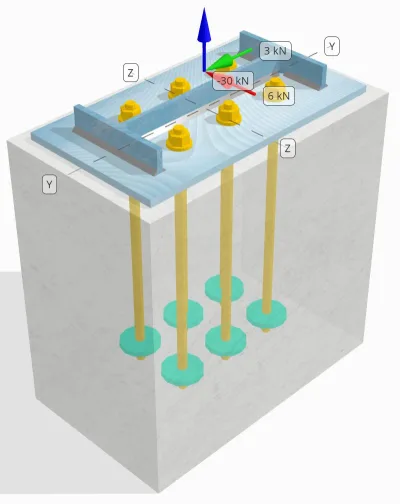
Προβληματική δήλωση
Determine whether the designed column-to-base plate connection is sufficient for 30 kN φορτίο εφελκυσμού, 3 kN Διατμητικό φορτίο, και 6 kN Vz διατμητικό φορτίο.
Δεδομένα
Στήλη:
Ενότητα στήλης: W14x30
Επιφάνεια στήλης: 5709.7 χιλ2
Υλικό στήλης: A992
Πλάκα βάσης:
Διαστάσεις πλάκας βάσης: 250 mm x 250 χιλ
Πάχος πλάκας βάσης: 12 χιλ
Υλικό πλάκας βάσης: A992
Πηκτώ:
Πάχος ενέματος: 0 χιλ
Σκυρόδεμα:
Διαστάσεις σκυροδέματος: 300 mm x 500 χιλ
Πάχος σκυροδέματος: 500 χιλ
Σκυρόδεμα: 20.7 MPa
Ραγισμένα ή αδιευκρίνιστα: Ραγισμένος
Άγκυρες:
Διάμετρος άγκυρας: 16 χιλ
Αποτελεσματικό μήκος ενσωμάτωσης: 400 χιλ
Anchor Ending: Circular Plate
Διάμετρος ενσωματωμένης πλάκας: 70 χιλ
Ενσωματωμένο πάχος πλάκας: 10 χιλ
Steel Material: F1554 Gr.55
Threads in Shear Plane: Included
Συγκολλήσεις:
Μέγεθος συγκόλλησης: 7 χιλ
Η ταξινόμηση μετάλλων πλήρωσης: Ε70ΧΧ
Δεδομένα αγκυροβόλησης (από Υπολογιστής Skyciv):
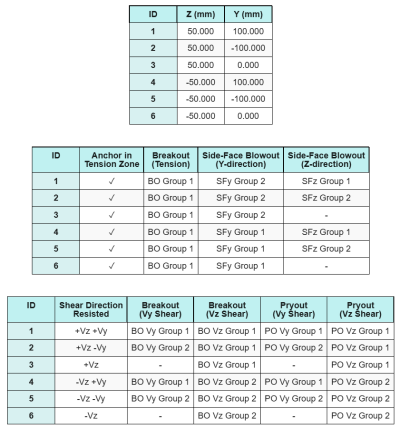
Μοντέλο στο δωρεάν εργαλείο SkyCiv
Μοντελοποιήστε το παραπάνω σχέδιο πλάκας βάσης χρησιμοποιώντας το δωρεάν διαδικτυακό μας εργαλείο σήμερα! Δεν απαιτείται εγγραφή.
Σημείωση
Ο σκοπός αυτού του παραδείγματος σχεδιασμού είναι να επιδείξει τους βαθμιαίους υπολογισμούς για ελέγχους χωρητικότητας που περιλαμβάνουν ταυτόχρονα διατμητικά και αξονικά φορτία. Ορισμένοι από τους απαιτούμενους ελέγχους έχουν ήδη συζητηθεί στα προηγούμενα παραδείγματα σχεδιασμού. Ανατρέξτε στους συνδέσμους που παρέχονται σε κάθε ενότητα.
Υπολογισμοί βήμα προς βήμα
Ελεγχος #1: Υπολογίστε τη χωρητικότητα συγκόλλησης
To determine the weld capacity under simultaneous loading, we first need to calculate the weld demand due to the shear load and the weld demand due to the φορτίο τάσης. You may refer to this Σύνδεσμος for the procedure to obtain the weld demands for shear, and this Σύνδεσμος for the tension weld demands.
For this design, ο weld demand at the web due to the tension load is found to be as follows, where the stress is expressed as δύναμη ανά μονάδα μήκους.
\(r_{εσύ,\κείμενο{ιστός}} = frac{T_{εσύ,\κείμενο{άγκυρα}}}{μεγάλο_{\κείμενο{εφ}}} = frac{5\ \κείμενο{ΚΝ}}{93.142\ \κείμενο{χιλ}} = 0.053681\ \κείμενο{kN / mm}\)
Επί πλέον, ο weld stress at any part of the column section due to the shear load is determined as:
\(v_{uy} = frac{V_y}{ΜΕΓΑΛΟ_{\κείμενο{συγκόλληση}}} = frac{3\ \κείμενο{ΚΝ}}{1250.7\ \κείμενο{χιλ}} = 0.0023987\ \κείμενο{kN / mm}\)
\(v_{να} = frac{V_z}{ΜΕΓΑΛΟ_{\κείμενο{συγκόλληση}}} = frac{6\ \κείμενο{ΚΝ}}{1250.7\ \κείμενο{χιλ}} = 0.0047973\ \κείμενο{kN / mm}\)
Since there is a combination of tension and shear loads at the ιστός, we need to obtain the resultant. Expressing this as force per unit length, έχουμε:
\(r_u = sqrt{(r_{εσύ,\κείμενο{ιστός}})^ 2 + (v_{uy})^ 2 + (v_{να})^ 2}\)
\(r_u = sqrt{(0.053681\ \κείμενο{kN / mm})^ 2 + (0.0023987\ \κείμενο{kN / mm})^ 2 + (0.0047973\ \κείμενο{kN / mm})^ 2}\)
\(r_u = 0.053949\ \κείμενο{kN / mm}\)
Για το πέλματα, only shear stresses are present. Ετσι, the resultant is:
\(r_u = sqrt{(v_{uy})^ 2 + (v_{να})^ 2}\)
\(r_u = sqrt{(0.0023987\ \κείμενο{kN / mm})^ 2 + (0.0047973\ \κείμενο{kN / mm})^ 2} = 0.0053636\ \κείμενο{kN / mm}\)
Επόμενο, υπολογίζουμε το weld capacities. For the flange, we determine the angle θ SkyCiv Renderer API Vz και Εσείς φορτία.
\( \theta = \tan^{-1}\!\αριστερά(\frac{v_{uy}}{v_{να}}\σωστά) = \tan^{-1}\!\αριστερά(\frac{0.0023987\ \κείμενο{kN / mm}}{0.0047973\ \κείμενο{kN / mm}}\σωστά) = 0.46365\ \κείμενο{rad} \)
συνεπώς, ο kds factor and weld capacity are calculated using AISC 360-22 Εξ. J2-5 και Εξ. J2-4.
\(κ_{δδ} = 1.0 + 0.5(\χωρίς(\θήτα))^{1.5} = 1 + 0.5 \φορές (\χωρίς(0.46365\ \κείμενο{rad}))^{1.5} = 1.1495\)
\(\phi r_{ν,flg} = \phi\,0.6\,F_{Exx}\,E_w\,k_{δδ} = 0.75 \φορές 0.6 \φορές 480\ \κείμενο{MPa} \φορές 4.95\ \κείμενο{χιλ} \φορές 1.1495 = 1.2291\ \κείμενο{kN / mm}\)
Για τον Ιστό, we calculate the angle θ using a different formula. Σημειώστε ότι Vuy is used in the formula since it represents the load parallel to the weld axis.
\( \theta = \cos^{-1}\!\αριστερά(\frac{v_{uy}}{r_u}\σωστά) = \cos^{-1}\!\αριστερά(\frac{0.0023987\ \κείμενο{kN / mm}}{0.053949\ \κείμενο{kN / mm}}\σωστά) = 1.5263\ \κείμενο{rad} \)
Χρησιμοποιώντας AISC 360-22 Εξ. J2-5 και Εξ. J2-4, ο kds factor and the resulting weld capacity are determined in the same manner.
\(κ_{δδ} = 1.0 + 0.5(\χωρίς(\θήτα))^{1.5} = 1 + 0.5 \φορές (\χωρίς(1.5263\ \κείμενο{rad}))^{1.5} = 1.4993\)
\(\phi r_{ν,ιστός} = \phi\,0.6\,F_{Exx}\,E_w\,k_{δδ} = 0.75 \φορές 0.6 \φορές 480\ \κείμενο{MPa} \φορές 4.95\ \κείμενο{χιλ} \φορές 1.4993 = 1.603\ \κείμενο{kN / mm}\)
Εν τέλει, we perform base metal checks for both the column and the base plate, then obtain the governing base metal capacity.
\( \phi r_{nbm,διάσελο} = \phi\,0.6\,F_{εσύ,διάσελο}\,αυτό είναι ένα πολύ σημαντικό στάδιο στο σχεδιασμό ενός τοίχου αντιστήριξης, καθώς η μη αντιστοίχιση των σωστών αναλογικών διαστάσεων από την αρχή σε κάθε στοιχείο μπορεί να οδηγήσει στην ανάγκη πολλών επαναλήψεων για να συμμορφωθεί ο τοίχος αντιστήριξης με τις απαιτήσεις ευστάθειας ή υπερμεγέθη σύστημα που πληροί όλες τις απαιτήσεις, αλλά χρησιμοποιεί πολύ περισσότερο υλικό από το θεωρητικό ελάχιστο{διάσελο,half} = 0.75 \φορές 0.6 \φορές 448.2\ \κείμενο{MPa} \φορές 3.429\ \κείμενο{χιλ} = 0.6916\ \κείμενο{kN / mm} \)
\( \phi r_{nbm,bp} = \phi\,0.6\,F_{εσύ,bp}\,αυτό είναι ένα πολύ σημαντικό στάδιο στο σχεδιασμό ενός τοίχου αντιστήριξης, καθώς η μη αντιστοίχιση των σωστών αναλογικών διαστάσεων από την αρχή σε κάθε στοιχείο μπορεί να οδηγήσει στην ανάγκη πολλών επαναλήψεων για να συμμορφωθεί ο τοίχος αντιστήριξης με τις απαιτήσεις ευστάθειας ή υπερμεγέθη σύστημα που πληροί όλες τις απαιτήσεις, αλλά χρησιμοποιεί πολύ περισσότερο υλικό από το θεωρητικό ελάχιστο{bp} = 0.75 \φορές 0.6 \φορές 400\ \κείμενο{MPa} \φορές 12\ \κείμενο{χιλ} = 2.1595\ \κείμενο{kN / mm} \)
\( \phi r_{nbm} = \min\big(\phi r_{nbm,bp},\ \phi r_{nbm,διάσελο}\μεγάλος) = min(2.1595\ \κείμενο{kN / mm},\ 0.6916\ \κείμενο{kN / mm}) = 0.6916\ \κείμενο{kN / mm} \)
We then compare the fillet weld capacities και base metal capacities for the weld demands at the flanges and web separately.
Από 0.053949 kN / mm < 0.6916 kN / mm, Η χωρητικότητα συγκόλλησης είναι επαρκής.
Ελεγχος #2: Υπολογίστε τη χωρητικότητα κάμψης πλάκας βάσης λόγω φορτίου τάσης
Ένα παράδειγμα σχεδίασης για την ικανότητα κάμψης της πλάκας βάσης έχει ήδη συζητηθεί στο Παράδειγμα σχεδίασης πλάκας βάσης για τάση. Ανατρέξτε σε αυτόν τον σύνδεσμο για τον βήμα προς βήμα υπολογισμό.
Ελεγχος #3: Υπολογίστε την ικανότητα εφελκυσμού της ράβδου άγκυρας
A design example for the anchor rod tensile capacity is already discussed in the Base Plate Design Example for Tension. Ανατρέξτε σε αυτόν τον σύνδεσμο για τον βήμα προς βήμα υπολογισμό. Ανατρέξτε σε αυτόν τον σύνδεσμο για τον βήμα προς βήμα υπολογισμό.
Ελεγχος #4: Υπολογίστε τη χωρητικότητα ξεμπλοκάρισμα από σκυρόδεμα σε ένταση
A design example for the capacity of the concrete in tension breakout is already discussed in the Base Plate Design Example for Tension. Ανατρέξτε σε αυτόν τον σύνδεσμο για τον βήμα προς βήμα υπολογισμό. Ανατρέξτε σε αυτόν τον σύνδεσμο για τον βήμα προς βήμα υπολογισμό.
Ελεγχος #5: Υπολογίστε την χωρητικότητα αγκύρωσης
A design example for the anchor pull out capacity is already discussed in the Base Plate Design Example for Tension. Ανατρέξτε σε αυτόν τον σύνδεσμο για τον βήμα προς βήμα υπολογισμό. Ανατρέξτε σε αυτόν τον σύνδεσμο για τον βήμα προς βήμα υπολογισμό.
Ελεγχος #6: Υπολογίστε την ικανότητα κάμψης της πλάκας
A design example for the supplementary check on the embedded plate flexural yielding capacity is already discussed in the Base Plate Design Example for Tension. Ανατρέξτε σε αυτόν τον σύνδεσμο για τον βήμα προς βήμα υπολογισμό.
Ελεγχος #7: Υπολογίστε την χωρητικότητα εκτόξευσης πλευρικού προσώπου σε κατεύθυνση y
Για να υπολογίσετε το Side-Face Blowout (SFBO) χωρητικότητα, we first determine the total tension force on the anchors closest to the edge. For this check, we will evaluate the capacity of the edge along the Y-direction.
Since the failure cone projections of the SFBO along the Y-direction overlap, the anchors are treated as an ομάδα άγκυρας.
The total tension demand of the anchor group is calculated as:
\(Ν_{κάνω} = αριστερά(\frac{N_x}{n_{ένα,τ}}\σωστά) n_{και,G1} = αριστερά(\frac{30\ \κείμενο{ΚΝ}}{6}\σωστά) \φορές 3 = 15\ \κείμενο{ΚΝ}\)
Επόμενο, καθορίζουμε το αποστάσεις ακμών:
\(ντο_{με,\ελάχ} = min(ντο_{\κείμενο{αριστερά},G1},\ ντο_{\κείμενο{σωστά},G1}) = min(100\ \κείμενο{χιλ},\ 200\ \κείμενο{χιλ}) = 100\ \κείμενο{χιλ}\)
\(ντο_{και,\ελάχ} = min(ντο_{\κείμενο{μπλουζα},G1},\ ντο_{\κείμενο{κάτω μέρος},G1}) = min(150\ \κείμενο{χιλ},\ 150\ \κείμενο{χιλ}) = 150\ \κείμενο{χιλ}\)
Using these edge distances, υπολογίζουμε το anchor group capacity συμφωνώς προς ACI 318-19 Εξ. (17.6.4.1).
\(Ν_{όπως και} = αριστερά(\frac{1 + \dfrac{ντο_{και,\ελάχ}}{ντο_{με,\ελάχ}}}{4} + \frac{μικρό_{άθροισμα,και,G1}}{6\,ντο_{με,\ελάχ}}\σωστά)\φορές 13 \φορές αριστερά(\frac{ντο_{με,\ελάχ}}{1\ \κείμενο{χιλ}}\σωστά)\φορές sqrt{\frac{ΕΝΑ_{brg}}{\κείμενο{χιλ}^ 2}}\ \lambda_a sqrt{\frac{f_c}{\κείμενο{MPa}}}\φορές 0.001\ \κείμενο{ΚΝ}\)
\(Ν_{όπως και} = αριστερά(\frac{1 + \dfrac{150\ \κείμενο{χιλ}}{100\ \κείμενο{χιλ}}}{4} + \frac{200\ \κείμενο{χιλ}}{6\φορές 100\ \κείμενο{χιλ}}\σωστά)\φορές 13 \φορές αριστερά(\frac{100\ \κείμενο{χιλ}}{1\ \κείμενο{χιλ}}\σωστά)\φορές sqrt{\frac{3647.4\ \κείμενο{χιλ}^ 2}{1\ \κείμενο{χιλ}^ 2}}\φορές 1 \φορές sqrt{\frac{20.68\ \κείμενο{MPa}}{1\ \κείμενο{MPa}}}\φορές 0.001\ \κείμενο{ΚΝ}\)
\(Ν_{όπως και} = 342.16\ \κείμενο{ΚΝ}\)
In the original equation, a reduction factor is applied when the anchor spacing is less than 6ca₁, assuming the headed anchors have sufficient edge distance. Ωστόσο, in this design example, Από ca₂ < 3ca₁, the SkyCiv calculator applies an additional reduction factor to account for the reduced edge capacity.
Τελικά, ο design SFBO capacity είναι:
\(\phi Ν_{όπως και} = \phi\,N_{όπως και} = 0.7 \φορές 342.16\ \κείμενο{ΚΝ} = 239.51\ \κείμενο{ΚΝ}\)
Από 15 ΚΝ < 239.51 ΚΝ, the SFBO capacity along the Y-direction is επαρκής.
Ελεγχος #8: Υπολογίστε την χωρητικότητα εκτόξευσης πλευρικού προσώπου στην κατεύθυνση z
Following the same approach as in Ελεγχος #7, the total tension demand of the anchor group for the anchors closest to the Z-direction edge is:
\(Ν_{κάνω} = αριστερά(\frac{N_x}{n_{ένα,τ}}\σωστά)n_{με,G1} = αριστερά(\frac{30\ \κείμενο{ΚΝ}}{6}\σωστά)\φορές 2 = 10\ \κείμενο{ΚΝ}\)
ο αποστάσεις ακμών are calculated as:
\(ντο_{και,\ελάχ} = min(ντο_{\κείμενο{μπλουζα},G1},\ ντο_{\κείμενο{κάτω μέρος},G1}) = min(150\ \κείμενο{χιλ},\ 350\ \κείμενο{χιλ}) = 150\ \κείμενο{χιλ}\)
\(ντο_{με,\ελάχ} = min(ντο_{\κείμενο{αριστερά},G1},\ ντο_{\κείμενο{σωστά},G1}) = min(100\ \κείμενο{χιλ},\ 100\ \κείμενο{χιλ}) = 100\ \κείμενο{χιλ}\)
ο nominal SFBO capacity is then determined as:
\(Ν_{όπως και} = αριστερά(\frac{1 + \dfrac{ντο_{με,\ελάχ}}{ντο_{και,\ελάχ}}}{4} + \frac{μικρό_{άθροισμα,με,G1}}{6\,ντο_{και,\ελάχ}}\σωστά)\φορές 13 \φορές αριστερά(\frac{ντο_{και,\ελάχ}}{1\ \κείμενο{χιλ}}\σωστά)\φορές sqrt{\frac{ΕΝΑ_{brg}}{\κείμενο{χιλ}^ 2}}\ \lambda_a sqrt{\frac{f_c}{\κείμενο{MPa}}}\φορές 0.001\ \κείμενο{ΚΝ}\)
\(Ν_{όπως και} = αριστερά(\frac{1 + \dfrac{100\ \κείμενο{χιλ}}{150\ \κείμενο{χιλ}}}{4} + \frac{100\ \κείμενο{χιλ}}{6\φορές 150\ \κείμενο{χιλ}}\σωστά)\φορές 13 \φορές αριστερά(\frac{150\ \κείμενο{χιλ}}{1\ \κείμενο{χιλ}}\σωστά)\φορές sqrt{\frac{3647.4\ \κείμενο{χιλ}^ 2}{1\ \κείμενο{χιλ}^ 2}}\φορές 1 \φορές sqrt{\frac{20.68\ \κείμενο{MPa}}{1\ \κείμενο{MPa}}}\φορές 0.001\ \κείμενο{ΚΝ}\)
\(Ν_{όπως και} = 282.65\ \κείμενο{ΚΝ}\)
Since the edge distance ca₂ is still less than 3ca₁, the same modified reduction factor is applied.
Τελικά, ο design SFBO capacity είναι:
\(\phi Ν_{όπως και} = \phi\,N_{όπως και} = 0.7 \φορές 282.65\ \κείμενο{ΚΝ} = 197.86\ \κείμενο{ΚΝ}\)
Από 10 ΚΝ < 197.86 ΚΝ, the SFBO capacity along the Z-direction είναι επαρκής.
Ελεγχος #9: Calculate breakout capacity (Με διάτμηση)
A design example for the concrete breakout capacity in Vy shear is already discussed in the Base Plate Design Example for Shear. Ανατρέξτε σε αυτόν τον σύνδεσμο για τον βήμα προς βήμα υπολογισμό.
Ελεγχος #10: Calculate breakout capacity (Vz διάτμηση)
A design example for the concrete breakout capacity in Vy shear is already discussed in the Base Plate Design Example for Shear. Ανατρέξτε σε αυτόν τον σύνδεσμο για τον βήμα προς βήμα υπολογισμό.
Ελεγχος #11: Υπολογίστε την ικανότητα εκτόξευσης (Με διάτμηση)
A design example for the capacity of the concrete against pryout failure due to Vy shear is already discussed in the Base Plate Design Example for Shear. Ανατρέξτε σε αυτόν τον σύνδεσμο για τον βήμα προς βήμα υπολογισμό.
Ελεγχος #12: Υπολογίστε την ικανότητα εκτόξευσης (Vz διάτμηση)
A design example for the capacity of the concrete against pryout failure due to Vy shear is already discussed in the Base Plate Design Example for Shear. Ανατρέξτε σε αυτόν τον σύνδεσμο για τον βήμα προς βήμα υπολογισμό.
Ελεγχος #13: Υπολογίστε την ικανότητα διάτμησης της ράβδου αγκύρωσης
Ένα παράδειγμα σχεδίασης για την ικανότητα διάτμησης της ράβδου αγκύρωσης έχει ήδη συζητηθεί στο Παράδειγμα σχεδίασης πλάκας βάσης για διάτμηση. Ανατρέξτε σε αυτόν τον σύνδεσμο για τον βήμα προς βήμα υπολογισμό.
Ελεγχος #14: Calculate anchor rod shear and axial capacity (AISC)
To determine the capacity of the anchor rod under combined shear and axial loads, χρησιμοποιούμε AISC 360-22 Εξ. J3-3a. In this calculator, the equation is rearranged to express the result as the modified shear strength instead.
ο shear demand ορίζεται ως το shear load per anchor.
\(V_{κάνω} = V_{κάνω} = 2.5\ \κείμενο{ΚΝ}\)
ο tension demand is expressed as the tensile stress in the anchor rod.
\(φά_{ut} = frac{Ν_{κάνω}}{ΕΝΑ_{ράβδος}} = frac{5\ \κείμενο{ΚΝ}}{201.06\ \κείμενο{χιλ}^ 2} = 24.868\ \κείμενο{MPa}\)
ο modified shear capacity of the anchor rod is then calculated as:
\(ΦΑ'_{nv} = \min\!\αριστερά(1.3\,ΦΑ_{nv} – \αριστερά(\frac{ΦΑ_{nv}}{\Phi f_{nt}}\σωστά) φά_{ut},\; ΦΑ_{nv}\σωστά)\)
\(ΦΑ'_{nv} = \min\!\αριστερά(1.3\φορές 232.69\ \κείμενο{MPa} – \αριστερά(\frac{232.69\ \κείμενο{MPa}}{0.75\φορές 387.82\ \κείμενο{MPa}}\σωστά)\φορές 24.868\ \κείμενο{MPa},\; 232.69\ \κείμενο{MPa}\σωστά) = 232.69\ \κείμενο{MPa}\)
We then multiply this strength by the anchor area χρησιμοποιώντας AISC 360-22 Εξ. J3-2.
\(\phi R_{ν,\κείμενο{aisc}} = phi F'_{nv} ΕΝΑ_{\κείμενο{ράβδος}} = 0.75 \φορές 232.69\ \κείμενο{MPa} \φορές 201.06\ \κείμενο{χιλ}💕⬛ Αγορά Indocin από 35.09\ \κείμενο{ΚΝ}\)
Από 2.5 ΚΝ < 35.09 ΚΝ, the anchor rod capacity is επαρκής.
Ελεγχος #15: Calculate interaction checks (ACI)
When checking the anchor rod capacity under combined shear and tension loads using ACI, a different approach is applied. For completeness, we also perform the ACI interaction checks in this calculation, which include other concrete interaction checks επισης.
Here are the resulting ratios for all ACI tension checks:
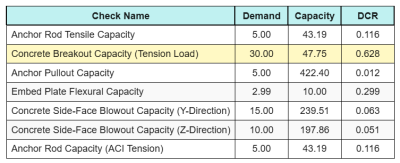
And here are the resulting ratios for all ACI shear checks:
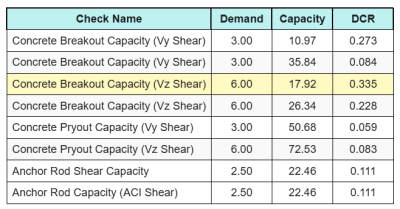
We get the check with the largest ratio and compare it to the maximum interaction ratio using ACI 318-19 Εξ. 17.8.3.
\(ΕΓΩ_{int} = frac{Ν_{κάνω}}{\phi N_n} + \frac{V_{κάνω}}{\phi V_n} = frac{30}{47.749} + \frac{6}{17.921} = 0.96308\)
Από 0.96 < 1.2, the interaction check is επαρκής.
Περίληψη σχεδίου
ο Λογισμικό σχεδιασμού πλάκας βάσης SkyCIV Μπορεί να δημιουργήσει αυτόματα μια αναφορά υπολογισμού βήμα προς βήμα για αυτό το παράδειγμα σχεδιασμού. Παρέχει επίσης μια περίληψη των επιταγών που εκτελούνται και των προκύπτουσων αναλογιών τους, καθιστώντας τις πληροφορίες κατανοητές με μια ματιά. Παρακάτω είναι ένας πίνακας συνοπτικών δείγματος, που περιλαμβάνεται στην αναφορά.
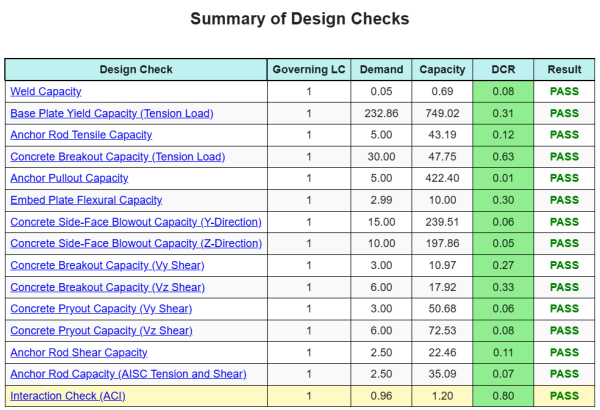
Αναφορά δείγματος SkyCIV
Δείτε το επίπεδο λεπτομέρειας και σαφήνειας που μπορείτε να περιμένετε από μια αναφορά σχεδίασης πλάκας βάσης SkyCiv. Η αναφορά περιλαμβάνει όλους τους βασικούς ελέγχους σχεδιασμού, εξισώσεις, και τα αποτελέσματα παρουσιάζονται σε σαφή και ευανάγνωστη μορφή. Είναι πλήρως συμβατό με τα πρότυπα σχεδιασμού. Κάντε κλικ παρακάτω για να προβάλετε ένα δείγμα αναφοράς που δημιουργήθηκε με χρήση του SkyCiv Base Plate Calculator.
Αγορά λογισμικού πλάκας βάσης
Αγοράστε την πλήρη έκδοση της μονάδας σχεδιασμού πλάκας βάσης από μόνη της χωρίς άλλες ενότητες SkyCIV. Αυτό σας δίνει ένα πλήρες σύνολο αποτελεσμάτων για σχεδιασμό πλάκας βάσης, συμπεριλαμβανομένων λεπτομερών αναφορών και περισσότερων λειτουργιών.


